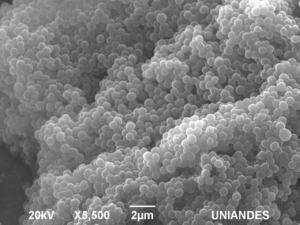UA Biophysics:Study of survival
Estudio deStudy of survival strategies of S. aureus biofilms exposed to membrane-active antimicrobial peptides

The action mechanism of antimicrobial peptides results in the destabilization of the biofilm structure. Biofilm sections are affected in different ways by the action of antimicrobial peptides, depending on the exposure of cells to the peptide. By the use of confocal microscopy, we want to determine the biofilm section that presents the greatest damage due to peptide activity, besides defining sub-populations within the biofilm that show greatest susceptibility to the antimicrobial peptide.
Study of the mechanical properties of lipid membranes in the presence of antimicrobial peptides

Antimicrobial peptides (AP) have the purpose of killing bacteria without harming human cells. A subgroup of these AP includes short peptides with positive charge, which induce transmembrane pores after a concentration threshold of peptides has adhered to the membrane.
We are interested in studying if adhered peptides modify the mechanical structure of membranes before pores are formed, affecting membrane function from the initial adhesion. These mechanical properties (bending modulus, elastic modulus, Young modulus) will be obtained by force spectroscopy measurements using the AFM microscope.